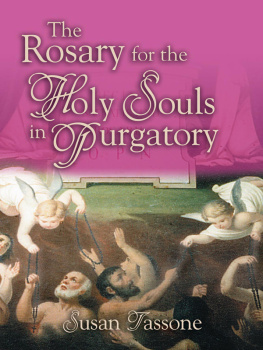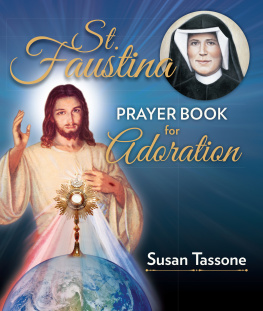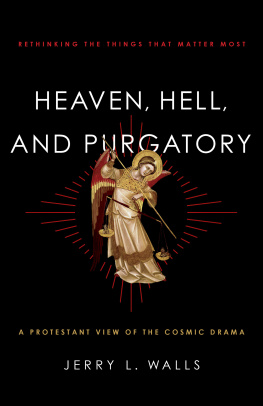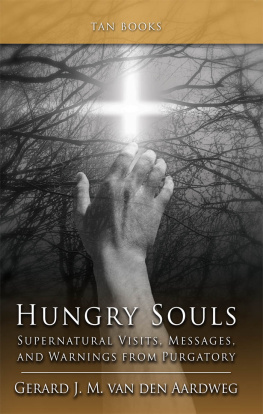Table of Contents
INSIDE
PURGATORY
What History, Theology and the
Mystics Tell Us about Purgatory
THOMAS W. PETRISKO
CONSECRATION
AND DEDICATION
This book is consecrated to the Merciful Heart of Christ. It is
dedicated to Fr. Richard Whetstone, a most faithful servant of our Father.
St. Andrews Productions
6111 Steubenville Pike
McKees Rocks, PA 15136
Copyright 2000 by Dr. Thomas W. Petrisko
ISBN 1-891903-24-1
All Rights Reserved
Toll-Free: (888) 654-6279
Phone: (412) 787-9754
Fax: (412) 787-5204
Web: www.SaintAndrew.com
E-mail: purgatory@saintandrew.com
Scriptural quotations are take from The Holy Bible RSV: Catholic Edition. Alternate translations from the Latin Vulgate Bible (Douay Rheims Version DV) are indicated when used. Some of the Scriptural quotations from the New American Bible: St. Joseph Edition, The New American Bible Fireside Family Edition 1984-1985, The Holy BibleDouay Rheims Edition, The New American Bible Red Letter Edition 1986.
Printed in the United States of America
ACKNOWLEDGMENTS
I wish to thank those most helpful to me during the writing of this
book: Robert and Kim Petrisko, Dr. Frank Novasack, Fr.
Richard Foley, Fr. Richard Whetstone, Fr. William McCarthy, Michael Fontecchio, Amanda DeFazio, Carole McElwain, Carol Jean Speck, Joan Smith, Jim Petrilena, Clyde Gualandri, John Haffert, Mrs. B. Laboissonniere, and the prayer group at the Pittsburgh Center for Peace.
I thank my family for the support and sacrifice they have made for this work, my wife Emily, daughters Maria, Sarah, Natasha, Dominique and my son, Joshua. As always, a special thank you to my mother and father, Andrew and Mary Petrisko and my uncle, Sam.
ABOUT THE AUTHOR
Dr. Thomas W. Petrisko was the President of the Pittsburgh
Center for Peace from 1990 to 1998 and he served as
editor of the Centers eight Special Edition newspapers. These papers, primarily featuring the apparitions and revelations of the Virgin Mary, were published in many millions throughout the world. He is the author of The Fatima Prophecies , At the Doorstep of the World; The Face of the Father , An Exclusive interview with Barbara Centilli Concerning Her Revelations and Visions of God the Father; Glory to the Father , A look at the Mystical Life of Georgette Faniel; For the Soul of the Family ; The Story of the Apparitions of the Virgin Mary to Estela Ruiz, The Sorrow, the Sacrifice and the Triumph ; The Visions, Apparitions and Prophecies of Christina Gallagher, Call of the Ages , The Prophecy of Daniel , In Gods Hands ; the Miraculous Story of Little Audrey Santo, Mother of The Secret , False Prophets of Today , St. Joseph and The Triumph of the Saints , The Last Crusade , The Kingdom of Our Father , and Inside Heaven and Hell .
Dr. Petrisko, along with his wife Emily, have four daughters, Maria, Sarah, Natasha, Dominique and a son, Joshua.
The decree of the Congregation for the Propagation of the Faith (AAS 58, 1186 - approved by Pope Paul VI on 14 October 1966) requires that the Nihil Obstat and Imprimatur are no longer required for publications that deal with private revelations, apparitions, prophecies, miracles, etc., provided that nothing is said in contradiction of faith and morals.
The author hereby affirms his unconditional submission to whatever final judgment is delivered by the Church regarding some of the events currently under investigation in this book.
Foreword
by Fr. Richard Foley, S.J.
As we have come to expect from Dr. Petrisko, he presents us with an in-depth wide-ranging treatment of the subject - matter. Which, in this his latest book, is Purgatory. He gives us the equivalent of a guided tour of Gods holy penitential world where human spirits are purified and thereby prepared for entry into Paradise. Thus readers will find an abundance of information about Purgatory. At the same time they will find in Dr. Petriskos book plenty of inspiration and encouragement to become more Purgatory minded; that is, generous in offering spiritual succour and support to the Holy Souls.
The notion of indispensable spiritual purification before going into Gods presence is, of course, a tradition as old as religion itself. But in Christianity its true meaning has been progressively developed under the action of the Holy Spirit. So much so, indeed, that Purgatory, as well as that closely-related truth known as the Communion of Saints, both now enjoy dogmatic status. In the 16th century these doctrines were comprehensively dealt with by the Council of Trent as part of its task of countering the heretical views of the so-called reformers; they taught, among other things, that Christs merits dispense us from the necessity of expiatory suffering in purification, whether in this world or in the next, on account of our personal sins.
Dr. Petrisko directs onto his subject many a spotlight coming from various authorities down the Christian centuries popes, theologians, saints, mystics and visionaries. Together their insights in testimonies present a rounded picture of that mysterious realm of purgatorial pain and prayer, which can be likened to Heavens vestibule lying beyond this world.
As is so often the case when examining faiths mysteries, it is the saints and mystics who shed much helpful illumination. Any number of them have been privileged to behold Purgatory, thus learning something of its set-up and the sort of sufferings the Holy Souls must endure; in some instances they were even allowed to converse with them.
Notable among these mystics was St. Catherine of Genoa; what impressed her most of all was the perfect conformism of Gods holy will on the part of the suffering souls and their deep-seated peace. Moreover, they fully appreciate that their penitential pain is in fact a precious grace from the All-Holy, who has decreed that nothing defiled shall enter Heaven.
St. Teresa of Avilas mystical experiences of Purgatory generated in her an immense compassion and charity towards its suffering inmates and a resolve to do all she could to bring them succour and solace. Indeed, she was often divinely enlightened to see how her prayers had served to liberate some of them and transport them to Heaven. St. Mary Magdalen of Pazzi frequently had a similar experience. And St. Margaret Mary learned from certain souls in Purgatory how its specific punishments match the kind and degree of particular sins and imperfections. As for St. Catherine of Sienna, she won from God the grace to suffer in her own body what her own father still had to endure in Purgatory; he was instantly released, and, radiant with heavily joy, appeared to her to express his deep gratitude for what she had done.
As regards the duration factor in Purgatory, St. Robert Bellarmine was convinced that its sufferings are not limited to a maximum of 10 or 20 year, as was commonly held; rather, they are to be reckoned in some cases as lasting an entire century. And as for the severity of purgatorial suffering, St. Thomas Aquinas held that the least particle of its pain even exceeds everything the Saviour had to endure during His passion. This view was endorsed by St. Mary Magdalen of Pazzi; in comparison with Purgatorys torments, shes on record as saying, the dungeons of the martyrs are gardens of delight.
As we would expect, the Mother of God plays a prominent role in the lives of her many children who are prisoners of divine justice in Gods austere kingdom of penitence and purification. It was revealed to St. Peter Damien that on each annual feast of the Assumption thousands of Holy Souls are released at our Ladys intercession.









